Abstract
The effects of aging on alcohol consumption behaviors are unclear because of confounding with period and cohort effects. In 1973, 1,859 male participants in the Normative Aging Study, born between 1892 and 1945, described their drinking behaviors by responding to a mailed questionnaire. In 1982, 1,713 of the participants in this study responded to a similar questionnaire. We used multivariate techniques, adjusting regression coefficients for the correlations between repeated responses of the same individuals, to assess the effects of birth cohort and aging on mean alcohol consumption level, on the prevalence of problems with drinking, and on the prevalence of averaging three or more drinks per day. Older men drank significantly less than younger men at both times yet there was no tendency for men to decrease their consumption levels over time. Each successively older birth cohort had a prevalence of problems with drinking estimated to be 0.037 lower than the prevalence of the next youngest cohort (95 per cent confidence interval: 0.029-0.045), yet there was no decrease in drinking problems over nine years. Interpretation of these findings requires consideration of the changes in attitudes as well as the increases in per capita consumption occurring in the United States throughout the 1970s. Results suggest that aging is not as important a factor in changes in drinking behaviors as generational or attitudinal changes.
Full text
PDF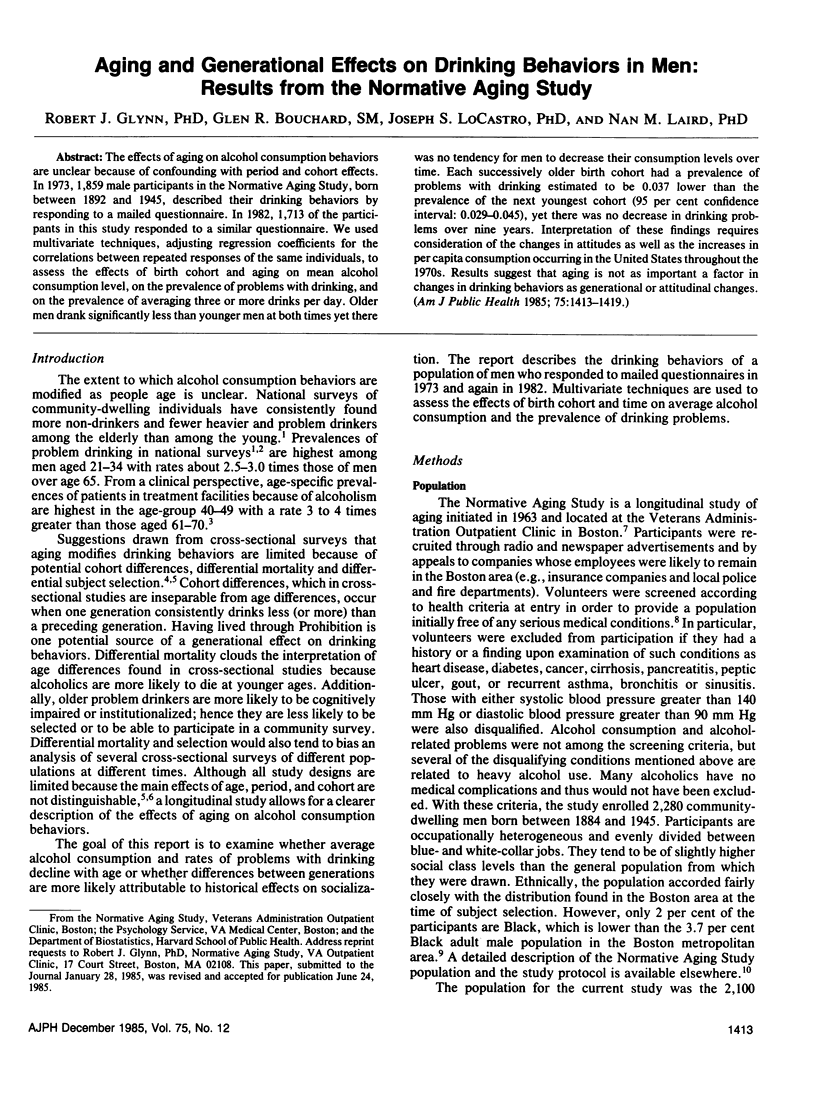
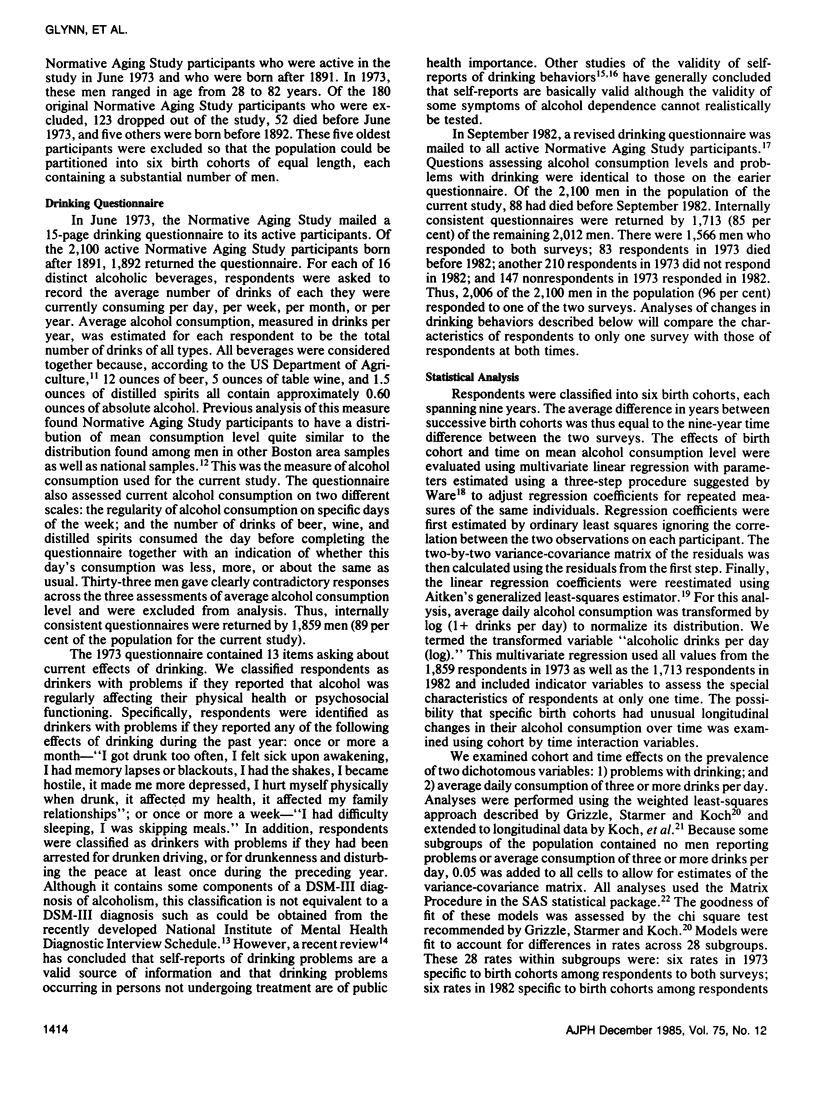
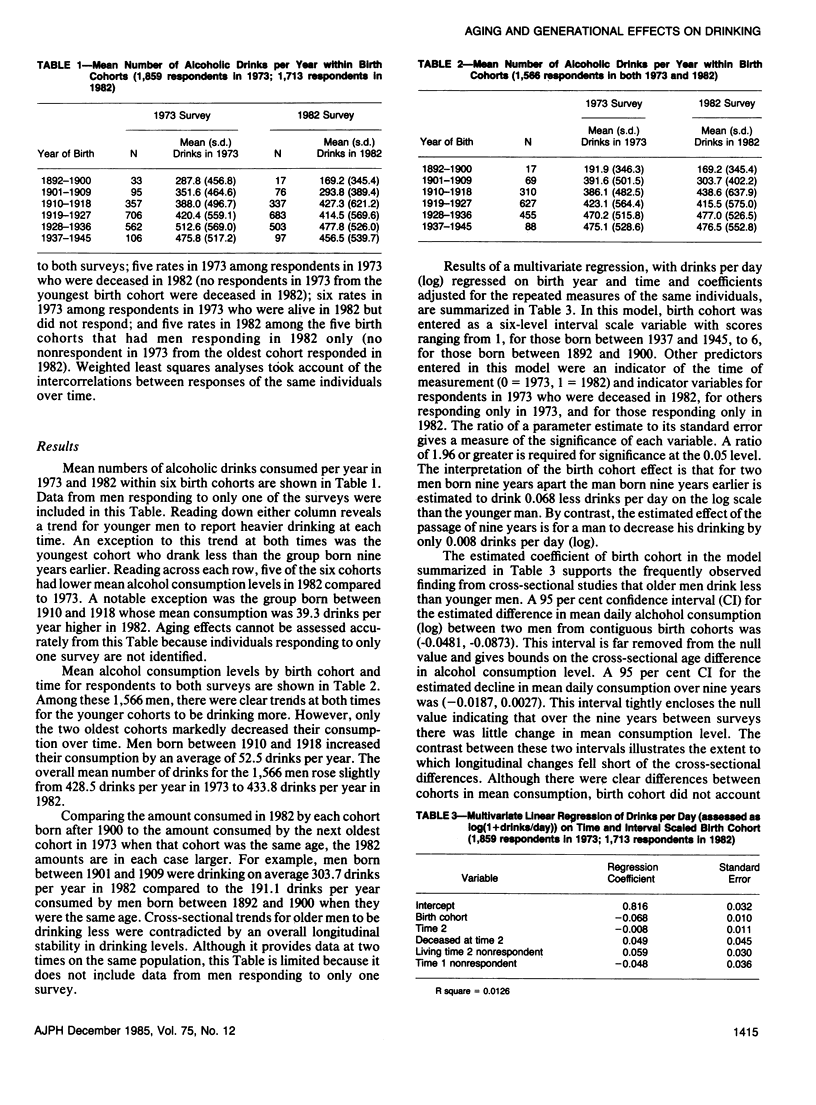
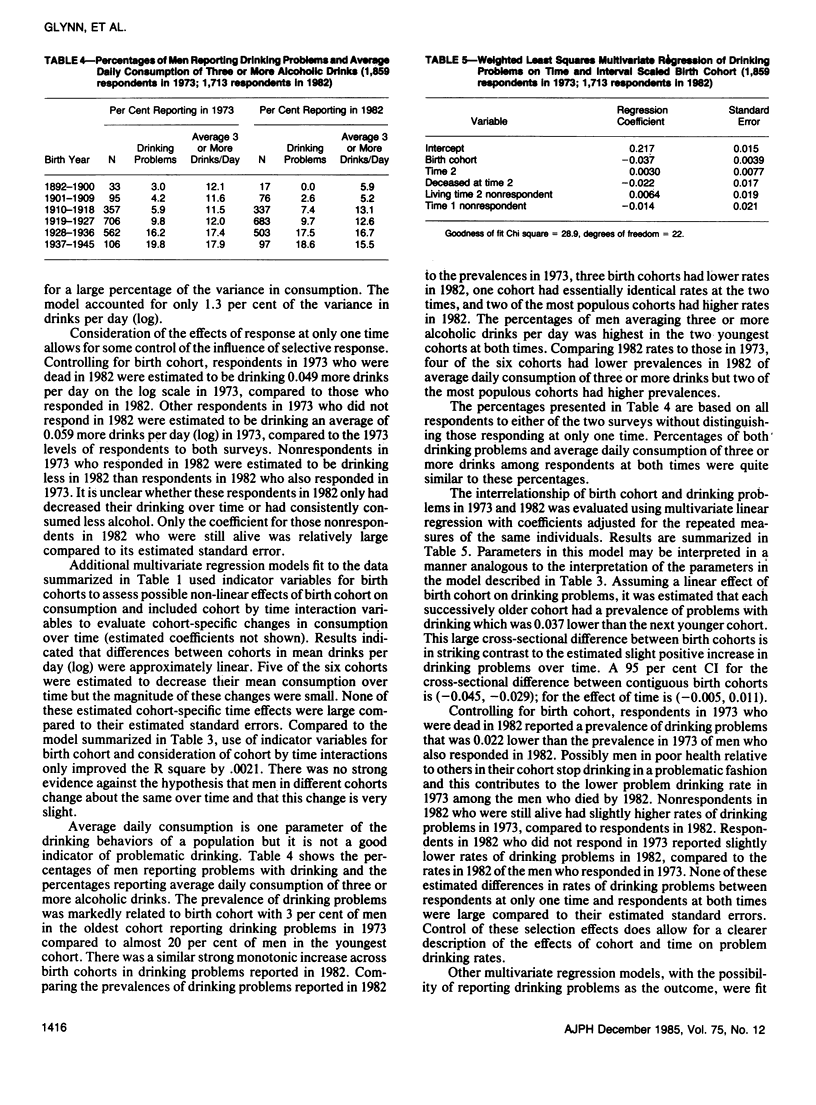

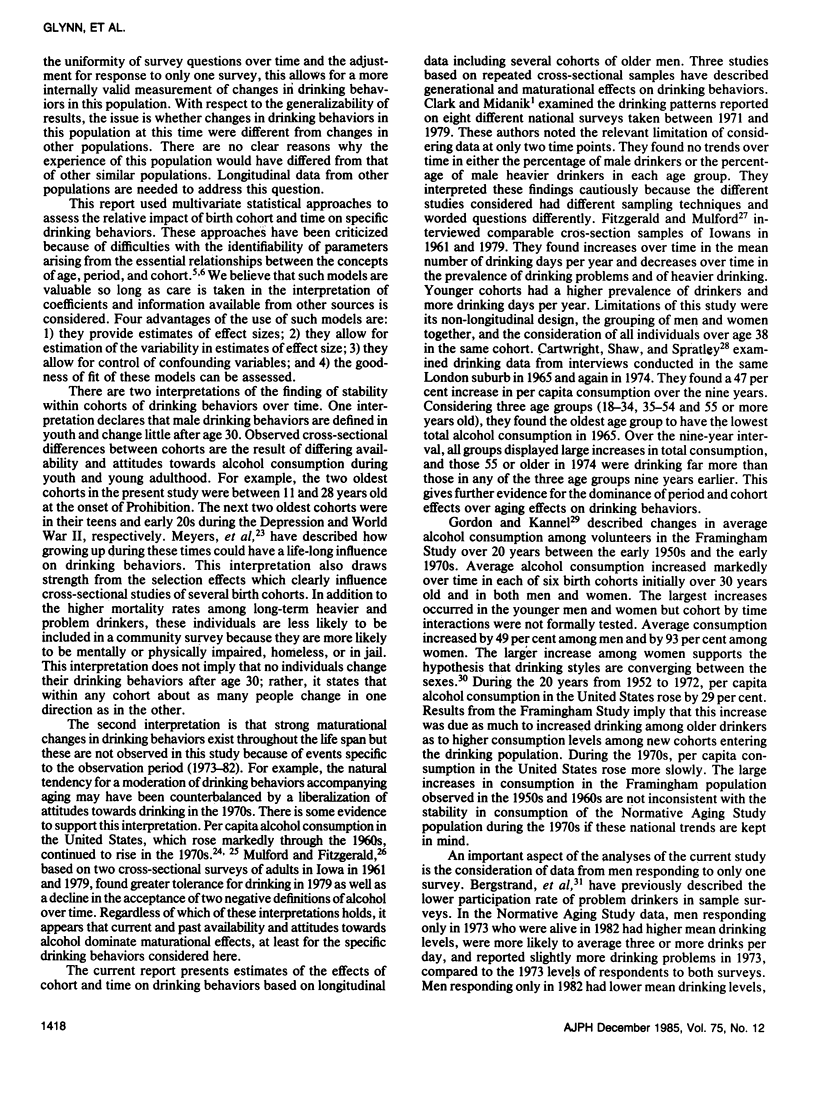
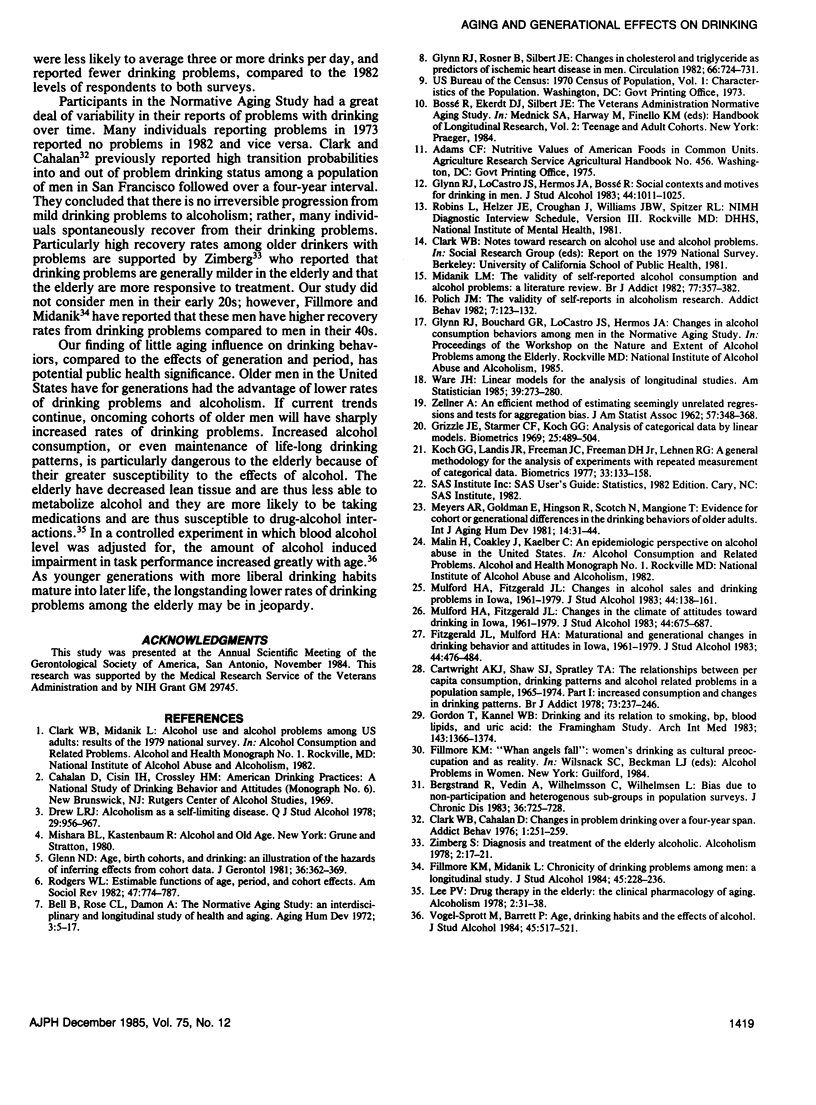
Selected References
These references are in PubMed. This may not be the complete list of references from this article.
- Bergstrand R., Vedin A., Wilhelmsson C., Wilhelmsen L. Bias due to non-participation and heterogenous sub-groups in population surveys. J Chronic Dis. 1983;36(10):725–728. doi: 10.1016/0021-9681(83)90166-2. [DOI] [PubMed] [Google Scholar]
- Blose I. L. The relationship of alcohol to aging and the elderly. Alcohol Clin Exp Res. 1978 Jan;2(1):17–21. doi: 10.1111/j.1530-0277.1978.tb04687.x. [DOI] [PubMed] [Google Scholar]
- Cartwright A. K., Shaw S. J., Spratley T. A. The relationships between per capita consumption, drinking patterns and alcohol related problems in a population sample, 1965--1974. Part I: increased consumption and changes in drinking patterns. Br J Addict Alcohol Other Drugs. 1978 Sep;73(3):237–246. doi: 10.1111/j.1360-0443.1978.tb00150.x. [DOI] [PubMed] [Google Scholar]
- Drew L. R. Alcoholism as a self-limiting disease. Q J Stud Alcohol. 1968 Dec;29(4):956–967. [PubMed] [Google Scholar]
- Fillmore K. M., Midanik L. Chronicity of drinking problems among men: a longitudinal study. J Stud Alcohol. 1984 May;45(3):228–236. doi: 10.15288/jsa.1984.45.228. [DOI] [PubMed] [Google Scholar]
- Fitzgerald J. L., Mulford H. A. Maturational and generational changes in drinking behavior and attitudes in Iowa, 1961-1979. J Stud Alcohol. 1983 May;44(3):476–484. doi: 10.15288/jsa.1983.44.476. [DOI] [PubMed] [Google Scholar]
- Glenn N. D. Age, birth cohorts, and drinking: an illustration of the hazards of inferring effects from cohort data. J Gerontol. 1981 May;36(3):362–369. doi: 10.1093/geronj/36.3.362. [DOI] [PubMed] [Google Scholar]
- Glynn R. J., LoCastro J. S., Hermos J. A., Bossé R. Social contexts and motives for drinking in men. J Stud Alcohol. 1983 Nov;44(6):1011–1025. doi: 10.15288/jsa.1983.44.1011. [DOI] [PubMed] [Google Scholar]
- Glynn R. J., Rosner B., Silbert J. E. Changes in cholesterol and triglyceride as predictors of ischemic heart disease in men. Circulation. 1982 Oct;66(4):724–731. doi: 10.1161/01.cir.66.4.724. [DOI] [PubMed] [Google Scholar]
- Gordon T., Kannel W. B. Drinking and its relation to smoking, BP, blood lipids, and uric acid. The Framingham study. Arch Intern Med. 1983 Jul;143(7):1366–1374. [PubMed] [Google Scholar]
- Grizzle J. E., Starmer C. F., Koch G. G. Analysis of categorical data by linear models. Biometrics. 1969 Sep;25(3):489–504. [PubMed] [Google Scholar]
- Koch G. G., Landis J. R., Freeman J. L., Freeman D. H., Jr, Lehnen R. C. A general methodology for the analysis of experiments with repeated measurement of categorical data. Biometrics. 1977 Mar;33(1):133–158. [PubMed] [Google Scholar]
- Meyers A. R., Goldman E., Hingson R., Scotch N., Mangione T. Evidence for cohort or generational differences in the drinking behavior of older adults. Int J Aging Hum Dev. 1981;14(1):31–44. doi: 10.2190/xcde-9eqy-5dnr-bux7. [DOI] [PubMed] [Google Scholar]
- Midanik L. The validity of self-reported alcohol consumption and alcohol problems: a literature review. Br J Addict. 1982 Dec;77(4):357–382. doi: 10.1111/j.1360-0443.1982.tb02469.x. [DOI] [PubMed] [Google Scholar]
- Mulford H. A., Fitzgerald J. L. Changes in alcohol sales and drinking problems in Iowa, 1961-1979. J Stud Alcohol. 1983 Jan;44(1):138–161. doi: 10.15288/jsa.1983.44.138. [DOI] [PubMed] [Google Scholar]
- Mulford H. A., Fitzgerald J. L. Changes in the climate of attitudes toward drinking in Iowa, 1961-1979. J Stud Alcohol. 1983 Jul;44(4):675–687. doi: 10.15288/jsa.1983.44.675. [DOI] [PubMed] [Google Scholar]
- Polich J. M. The validity of self-reports in alcoholism research. Addict Behav. 1982;7(2):123–132. doi: 10.1016/0306-4603(82)90037-5. [DOI] [PubMed] [Google Scholar]
- Schuckit M. A., Pastor P. A., Jr The elderly as a unique population: alcoholism. Alcohol Clin Exp Res. 1978 Jan;2(1):31–38. doi: 10.1111/j.1530-0277.1978.tb04690.x. [DOI] [PubMed] [Google Scholar]
- Vogel-Sprott M., Barrett P. Age, drinking habits and the effects of alcohol. J Stud Alcohol. 1984 Nov;45(6):517–521. doi: 10.15288/jsa.1984.45.517. [DOI] [PubMed] [Google Scholar]


